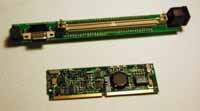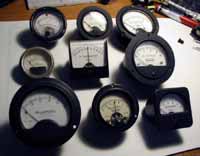The ‘Meter Thing’ — to be granted a better name when one occurs to me — is a project to display on a set of vintage analog meters several numeric data (or data that can be turned into numbers) scraped from the Internet.
 The heart of the beast is an older model TINI, a little Java computer with Ethernet and loads of I/O, all in the shape of a 72-pin SIMM — roughly the height, width and maybe a third the thickness of a pack of gum (although newer models use the DIMM form factor). This sits in an extremely simple breakout board, which basically just provides a RJ45 network jack and a breadboard-compatible set of DIP pins for all 72 conductors on the SIMM. The meters I bought in a lot of ten on eBay. They are all from different sources, are different sizes, and have different units and scales displayed.
The heart of the beast is an older model TINI, a little Java computer with Ethernet and loads of I/O, all in the shape of a 72-pin SIMM — roughly the height, width and maybe a third the thickness of a pack of gum (although newer models use the DIMM form factor). This sits in an extremely simple breakout board, which basically just provides a RJ45 network jack and a breadboard-compatible set of DIP pins for all 72 conductors on the SIMM. The meters I bought in a lot of ten on eBay. They are all from different sources, are different sizes, and have different units and scales displayed.
 The first challenge is to generate the analog signal for the meters. My original idea was to use 1-Wire digital potentiometers. The TINI supports 1-Wire exceptionally well, which is not surprising, as it has invented by the same people. 1-Wire would let me add meters as needed, just attaching them to the 1-Wire bus; I could then direct data to them by the unique ID of each 1-Wire potentiometer.
The first challenge is to generate the analog signal for the meters. My original idea was to use 1-Wire digital potentiometers. The TINI supports 1-Wire exceptionally well, which is not surprising, as it has invented by the same people. 1-Wire would let me add meters as needed, just attaching them to the 1-Wire bus; I could then direct data to them by the unique ID of each 1-Wire potentiometer.
The problem with the digital potentiometers is the lack of range. Using the potentiometers to drive the analog meters directly did not give me the even coverage I need. The meters, regardless of their displayed units, are ammeters. Adjusting the resistance gives me a reciprocal curve (if I’m using the term correctly): x/1, x/2, x/3, et cetera.
I need some sort of ‘real’ digital/analog conversion; either PWM or some more sophisticated DAC chip. 8 bits of resolution are probably enough; if a meter has an arc of 60 degrees, that gives me increments less than half a percent. I have a couple of candidates in mind.
More background on this project and its current status to come.
 The heart of the beast is an older model
The heart of the beast is an older model  The first challenge is to generate the analog signal for the meters. My original idea was to use 1-Wire digital potentiometers. The TINI supports 1-Wire exceptionally well, which is not surprising, as it has invented by the same people. 1-Wire would let me add meters as needed, just attaching them to the 1-Wire bus; I could then direct data to them by the unique ID of each 1-Wire potentiometer.
The first challenge is to generate the analog signal for the meters. My original idea was to use 1-Wire digital potentiometers. The TINI supports 1-Wire exceptionally well, which is not surprising, as it has invented by the same people. 1-Wire would let me add meters as needed, just attaching them to the 1-Wire bus; I could then direct data to them by the unique ID of each 1-Wire potentiometer.